Ginger plants are categorised into three groups: Wild, Ornamental and Edible types. Edible ginger varieties are grown for their spicy roots and leaves whereas Ornamental ginger plants are grown for their flowers and foliage for the ornamental/floristry market. Wild gingers on the other hand grow in the wild and are generally used as ground covers. Ginger plant varieties include:
- Bitter Ginger
- Fingerroot ginger
- Shell Ginger
- Young Ginger
- Culinary/Common Ginger
- Blue Hawaiian Ginger
- Peacock Ginger
- Shampoo Ginger
- Shell Ginger
- Ginger Lily
- Beehive Ginger
- Myoga Ginger
- Crepe Ginger
- Red Ginger
- Dancing Ladies Ginger
- Torch Ginger
- Kahili Ginger
Edible/Culinary Ginger Varieties
Edible or culinary ginger, botanically classified as Zingiber officinale, is the underground rhizome or root stem of a tropical herb that can grow up to one meter in height above ground and belongs to the Zingiberaceae family along with cardamom and turmeric. There are over 1,300 species of Ginger that are found across the world in tropical climates, and the rhizome has a unique growth pattern of traveling horizontally underground, producing new roots and stems to propagate the perennial plant. Ginger is grown for the hot, pungent flavor of the rhizome which can be used fresh, dried, ground or preserved (in brine, vinegar or sugar syrup). Ginger adds a spicy punch to fruit salads, teas, curries, preserves, and baked goods – gingerbread, gingersnaps, and other spicy desserts. In addition to its culinary value, it is used medicinally for several ailments. It does interact with some medications, including the anticoagulant drug warfarin.
Common Ginger

Common ginger is a knobby, multiple branched rhizome found in many different shapes and sizes. The skin ranges in color from light to dark tan, depending on the variety, and is semi-rough with occasional callouses and rings ridged along the surface. The thickness of the skin is directly related to whether the rhizome was picked early or mature. Underneath the skin, the flesh is firm, fibrous, and ranges in color from yellow to brown. The rhizome is also highly fragrant with a warm, woody scent. When fresh, Ginger is juicy and crunchy with a pungent, spicy, and slightly sweet taste.
Bitter Ginger

Bitter ginger is known by several names, including Lempoyang in Malaysia and Indonesia, Pinecone ginger, Shampoo ginger, Hong Qiu Jiang in China, Awapuhi in Hawaii, and Wild ginger. Bitter ginger plants are comprised of long, thin, and leafy, upright stalks that produce 10 to 12 oval to oblong leaves ranging from 15 to 20 centimeters in length. In the summer, the plants develop cone-like inflorescences that taper slightly at the top, covered in overlapping scales, also known as bracts, averaging 3 to 10 centimeters in length. The scaly, waxy, and smooth inflorescences are green when young, transitioning into a bright red hue over time. The inflorescences also produce a few small yellow-white flowers and a slimy, viscous, and slippery liquid when mature. This liquid has a pleasant and refreshing ginger-like smell. Underneath the leafy plant, Bitter ginger develops long and skinny rhizomes approximately 2 to 3 centimeters in diameter with a knobby, variable appearance.
Also Read: Different Types of Kale Varieties
Finger Root

Fingerroot ginger is comprised of 3 to 4 broad, light green leaves that grow upright, averaging 7 to 12 cm in width and 25 to 50 centimeters in length. The leaves are oblong to elliptical in shape and showcase vertical grooves across the surface, sometimes encased in red sheaths. Beneath the leaves, small underground rhizomes form a globular base, sending finger-like offshoots out, giving the ginger an unusual appearance. Each slender rhizome offshoot ranges from 5 to 10 centimeters in length and has a straight to slightly tapered, cylindrical shape with a swollen, bulbous center and pointed tips. The rhizome’s skin is thin, textured, and light brown, being easily peeled to reveal a yellow flesh.
Young Ginger
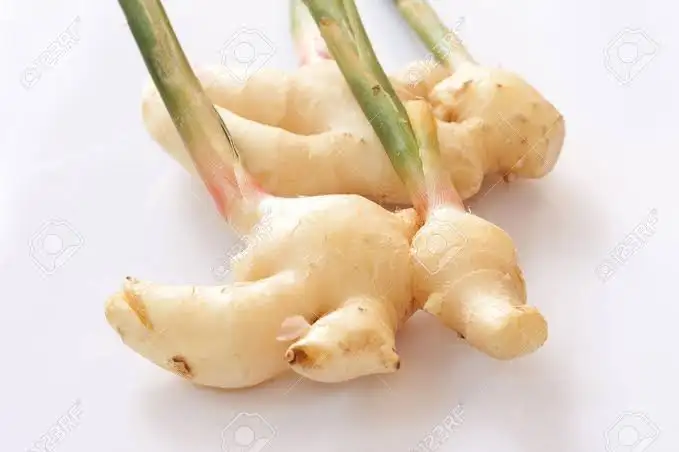
Young Ginger is a knobby, multiple branched rhizome found in many different shapes and sizes growing up to ten centimeters in length. The skin is devoid of the rough callousness that is found in mature ginger and is so thin that it can easily be removed by hand. The skin is also smoother and has a light cream-colored to tan base with some darker brown spots and pink blushing around the tips. Underneath the skin, the ivory to cream-colored flesh is almost fiber-free and is juicy, swollen, and crisp. Young Ginger is aromatic and tender with a mildly peppery, floral, and sweet taste.
Also Read: Different Types of Edible Mushrooms
Temu Ireng
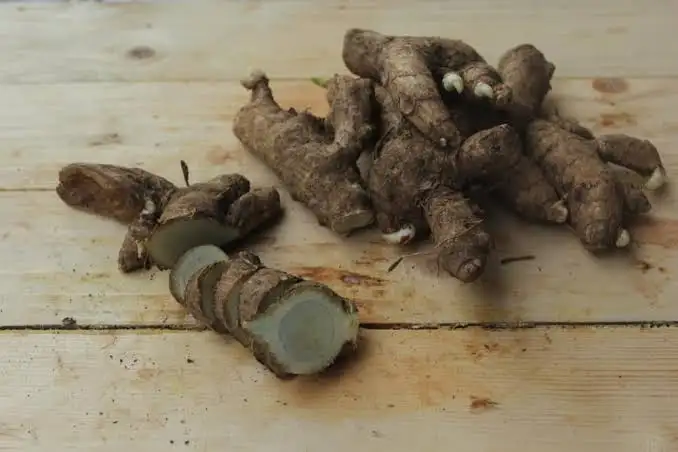
Temu Ireng is a flowering plant comprised of elongated, lanceolate-shaped, ridged leaves, 31 to 84 centimeters in length, with a single stalk emerging from the center. The stalk is topped with green bracts encasing pink to purple-red flowers splashed with yellow tones. The plant also grows large underground clusters of rhizomes, showcasing a central, cylindrical to oval root, averaging 8 to 10 centimeters in length and 2 to 5 centimeters in diameter, with several irregularly shaped offshoots extending from the central rhizome. The skin is rough, flaky, and tough, showcasing variegated hues of tan, brown, to dark brown with nodes, rings, and bumps. Underneath the surface, the flesh ranges in color from golden yellow, yellow-green, to a grey-green hue with a blue tint, depending on the size of the rhizome and cultivation. The flesh is firm, dense, moist, and fibrous with a chewy, snap-like consistency.The rhizomes are not commonly consumed in culinary preparations and are mainly used for medicinal purposes, their flavor subdued by sweeter ingredients.
Red Ginger

Ornamental Varieties
Despite the name, ornamental ginger does not have roots useful in cooking. Rather it is grown for its ornamental uses, as a specimen plant or in masses at the edges of gardens or beds. Its tendency to grow outward and naturalize makes it a good border plant, and its height offers privacy. Its blooms are also lovely cut and arranged in vases.
Shell Ginger

Alpinia zerumbet, commonly known as shell ginger, is a perennial species of ginger native to East Asia. They can grow up to 8 to 10 ft tall and bear colorful funnel-shaped flowers. They are grown as ornamentals and their leaves are used in cuisine and traditional medicine.The species can grow up to 10 feet tall, but in gardens, and especially in northern areas where grown as an annual, they generally only get 3 or 4 feet tall.The rhizomes produce stout, slightly arching stems with evergreen leaves. Several dark green, lance-shaped leaves up to 2 feet long grow at intervals along the stems.Unlike most gingers, this species produces drooping racemes at the ends of the leafy stems rather than directly from the rhizomes. The waxy, funnel-shaped flowers are a pearly white tinged with light pink on the outside, but inside are bright yellow with red markings. The flowers are slightly fragrant when in bloom. Sometimes flowers are followed by striated fruits.
Torch Ginger

Torch Ginger flowers are comprised of elongated, tapered buds on top of tall stalks stabilized by underground rhizomes. The green, fleshy stalks are thick and fibrous, reaching up to one meter in height, and grow upright in a stiff, straight formation. At the top of the stalks, the buds have a teardrop to oval shape, averaging ten centimeters in length, and are comprised of oval and waxy, petal-like layers known as bracts, protective, modified leaf coverings that encase the developing petals. When young, Torch Ginger flowers are tightly closed, forming a flame-like shape, and range in color from pink, red, to white. As the flower blooms, the bracts will open, revealing small colorful flower petals. Torch Ginger flowers are consumed when the buds are somewhat closed and have a crisp, succulent, and lightweight texture. The aromatic bracts also emit a sweet, floral, and subtly ginger-like scent and have a sweet and sour, piquant flavor with citrus-forward nuances.
Kahili Ginger
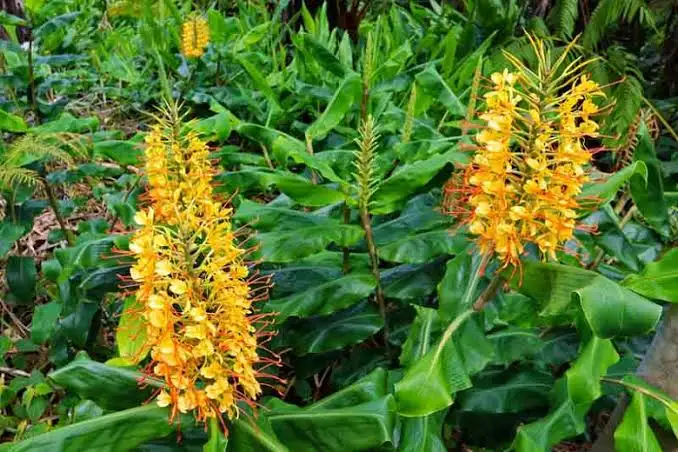
Kahili ginger is a large herbaceous plant with rapid vegetative growth. The annual, upright pseudostems arise from thick, perennial rhizomes. In the ground it can grow to 8 feet tall but is generally much shorter in container culture. The widely-spaced, alternate leaves clasp the thick stems in two parallel ranks. They are glossy green on the upper surface and powdery-white below. The showy flower spikes appear in late summer or early fall.The bright yellow flowers, each with a single, prominent stamen, emerge from cylindrical cones of green bracts. kahili ginger is used as a seasonal or greenhouse plant. The foliage of kahili ginger is dramatic and architectural, so it looks great even not in bloom in summer on patios or decks with a tropical theme.
Also Read: Different Types of Vegetables
Peacock Ginger
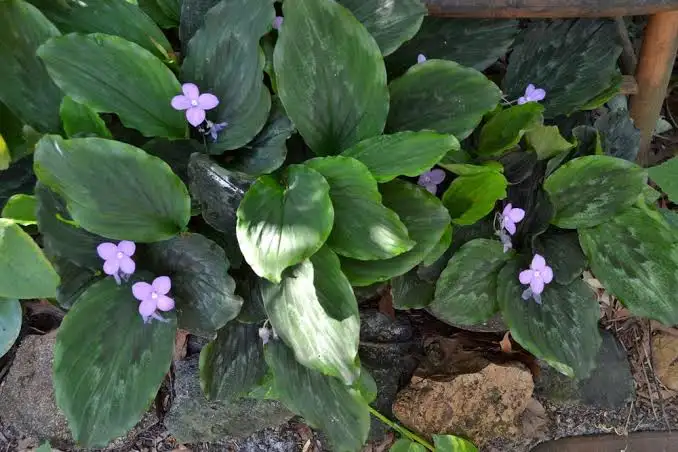
Peacock gingers are shade-loving perennials that make great groundcovers here in Florida. Most bloom throughout the summer with small pink or purple flowers, but peacock gingers are best known for their beautiful leaves.The round or oval leaves can be 4 to 10 inches long and typically feature a green background overlaid with bold markings in bronze, purple, or silver, though some varieties also have solid green leaves. Their broad leaves and low growth habit allow peacock gingers to serve as a lovely stand-in for hostas, a favorite of many gardeners who would love to try something new.
Ornamental Red ginger

Also known as as pink cone ginger, fire ginger, ostrich plume and pine cone ginger widely grown as a potted plant and landscape ornamental for its brilliant red flower bracts and glossy dark-green foliage. It has naturalized throughout the Hawaiian island chain, where it is known as ‘awapuhi ‘ula ‘ula.The flower stalks emerge slowly over the course of roughly four to five months before the 6- to 12-inch-long flower spikes form. Rarely, the flowers ripen into globular fruit containing oily black seeds encased in a shiny red casing called an aril. Red ginger plant works well as a focal plant or even a shrubby hedge, although growers in most areas have the best luck growing it as a potted plant indoors due to its extreme sensitivity to cold, harsh sunlight and dry conditions.
Beehive Ginger
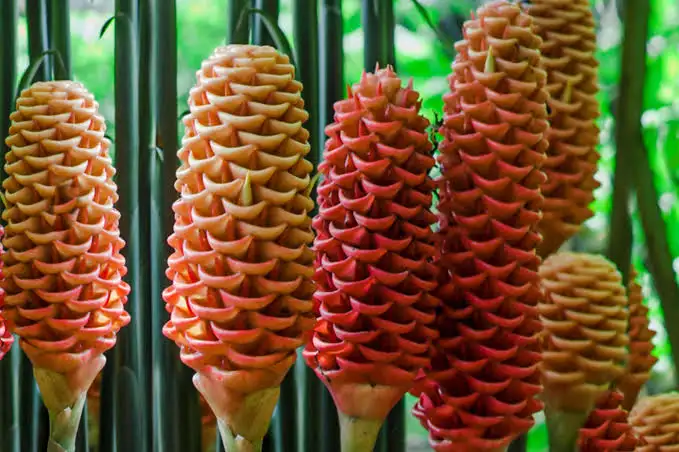
Beehive ginger plants are a species of ornamental ginger cultivated primarily for their distinctive appearance. Colorful and exotic in appearance, these stunning flowers instantly add a dash of the tropics to any room or garden, even in urban areas. These plants can grow to more than 6 feet in height, with leaves up to a foot long. No matter where you place them, they will be noticed. The plants get their common name from the fact that the bracts, which are modified leaves, grow in the shape of a beehive. The beehive, which slowly turns from yellowish-green to brilliant red, sits atop a long, slender stalk. The tiny white flowers, which bloom between the bracts, are rather insignificant in appearance. Beehive gingers are also prized as cut flowers because the colorful bracts last a long time after being cut.
Pineapple Ginger
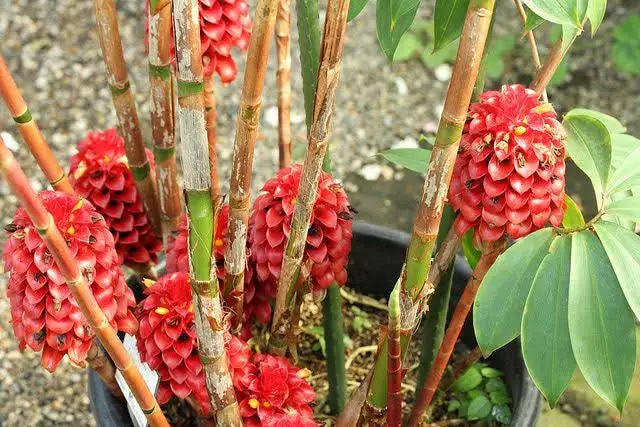
The most popular of these species grow on tall, leafless, reed-like stems that arise from the ground and are topped with a whorl of green, tropical-looking leaves. When it flowers, the inflorescences erupt directly from the ground on short stems at the feet of the taller leaf stalks. The inflorescences are upright and deep red, featuring waxy red bracts very much like some of the other cone-type ginger flowers.The white flowers are tucked inside this striking bract, which resembles a pineapple only in shape.
Blue Hawaiian ginger
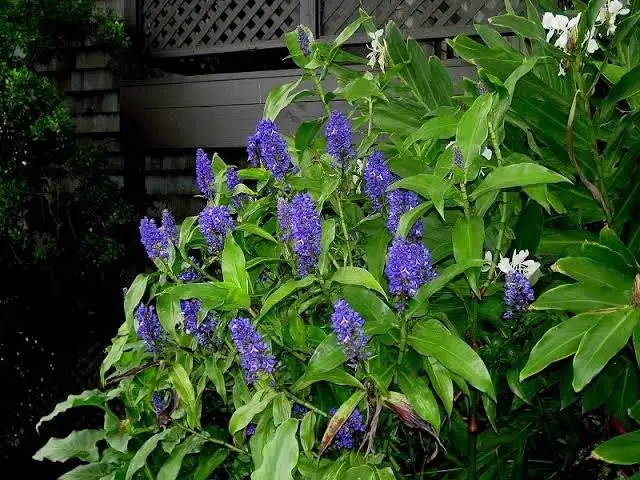
Blue Hawaiian ginger starts out with gawky upright stems ringed with shiny green leaves marked lightly in purple and silver. Toward the end of summer, each stalk produces a terminal three- to four-inch-inch wand of nubby blue buds that swell to fat beads before popping open into golden-eyed, starry blue flowers. In temperate climates, the flowers open over an incredibly long time—the full flowering can last six to eight weeks. In tropical conditions, they open more quickly, but the plant can produce multiple flushes of bloom throughout the autumn.
Also Read: Different Types of Cabbage To Grow At Home
Wild Ginger Varieties
Wild ginger is easily identifiable by its heart-shaped fuzzy leaves that seem to glimmer in sunlight and an unusual looking small red flower that grows out of the leaf base and droops to the ground. Found mostly on dry to slightly moist woodland slopes, this plant can form dense colonies on the forest floor below a traditional open canopy of oak, sycamore, and hickory.
Hartweg’s wild ginger

This is a perennial herb growing from a ginger-scented rhizome which extends vertically deep into the ground. It forms a clump of elaborately white-veined leaves which are heart-shaped to round in shape and coated in curved hairs. Each is borne on a long petiole up to 21 centimeters long. It bears a solitary flower near the ground on a short peduncle. The flower has no petals but three curving, hairy, brownish or maroon sepals which are whitish with red stripes on their inner surfaces.
Lemmon’s wild ginger
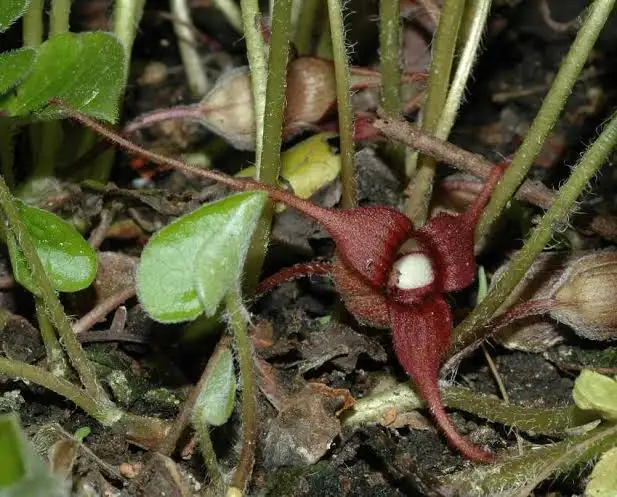
Asarum lemmonii also known by the common name Lemmon’s wild ginger. It is a spreading plant which forms dense green mats on the ground. The leaves are rich green and heart-shaped. It bears a small cup-shaped flower which is red externally and white inside. It bears a small cup-shaped flower which is red externally and white inside. The plant grows in moist areas.
Marbled wild ginger
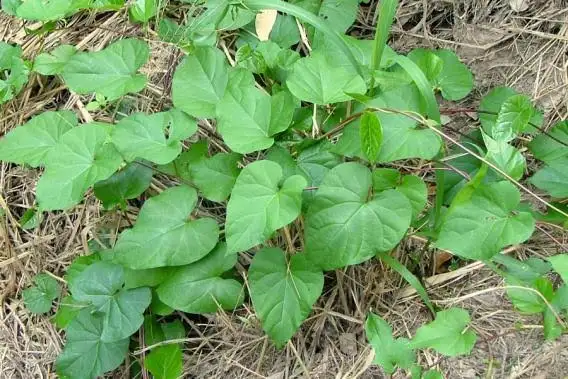
This is a rhizomatous perennial herb with hairy green leaves with bright cream-white colored marbling. The leaves are heart-shaped to kidney-shaped to nearly round. Flowers appear at ground-level. They consist of three coarsely hairy sepals which are dark greenish brown outside and dark reddish inside. The fruit is a fleshy capsule containing many seeds.
Further References
- Types of Ginger : https://www.24mantra.com/blogs/organic-food/different-types-of-ginger-and-their-uses/
- Facts about Ginger: https://en.m.wikipedia.org/wiki/Ginger
- Types of Ginger: https://www.bhg.com/recipes/how-to/cooking-basics/ginger-varieties/
- Types of Ginger: https://www.homeperch.com/different-types-of-fresh-ginger/